Laptop Mag Verdict
The 13-inch ASUS U31JG-A1 offers graphics muscle and long battery life in a thin and light design, but it's not quite the best notebook in its class.
Pros
- +
Solid graphics performance for 13-incher
- +
More than 6 hours of battery life
- +
Runs relatively cool
- +
Accurate webcam
- +
Brushed aluminum lid
Cons
- -
Display has narrow vertical viewing angles
- -
Keyboard flexes
- -
Slow boot time
Why you can trust Laptop Mag
Graphics oomph doesn't have to come at the expense of long battery life. Consider the ASUS U31JG-A1, a 13-inch laptop that combines Nvidia's Optimus technology with well over 6 hours of endurance. The Core i3 processor under the hood isn't the latest and greatest, but this thin-and-light machine has a lot to offer for $814. Is this notebook good enough to rise to the top of your shopping list?
Design
The U31JG looks identical to the 14-inch version of this notebook, the U41JF. It starts strong with a brushed aluminum lid that feels sturdy. When you flip it open you'll see a two-tone design that's handsome but somewhat conservative. The area around the keyboard is glossy black, while the deck is silver plastic. We appreciated little aesthetic flourishes such as the textured cross-hatch pattern above the keyboard and the mirrored touchpad button. Overall, though, we prefer the sleeker, more modern design of ASUS' U36JC-A1, which is practically all black and sports a soft-touch finish.
Weighing 4.2 pounds and measuring 13.1 x 9.5 x 0.8-1.2 inches, the U31JG-A1 doesn't make the cut-off for what we consider an ultraportable (under 4 pounds), but it's certainly easy to slip the system into a bag. While the 13-inch MacBook Pro is heftier (4.6 pounds), the MSI X370 (3.8 pounds, 0.8 inches thin), HP Pavilion dm3t (4 pounds, 1 inch), and Toshiba Portege R835 (3 pounds, 0.7-1.1 inches) are all thinner and lighter. Even ASUS's own 13-inch U36JC-A1 is more portable, at 3.8 pounds and 0.8 inches.
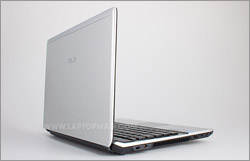
Click to enlargeAbove the keyboard you'll find a power button on the right side and a shortcut button that activates the Quick Start OS, for those who don't want to boot Windows to start surfing the web.
Keyboard and Touchpad
ASUS isn't known for great keyboards, and this model is no exception. The chiclet-style layout on the U31JG provided adequate feedback when typing this review, but we wish certain keys were larger--like the right Shift key--especially since there's unused space on the deck. We also noticed some flex. As per usual, adjusting the brightness, volume, and other settings on the keyboard requires a function key combo, as opposed to more convenient direct action keys.
The 3.1 x 1.8-inch touchpad on the U31JG-A1 is a bit on the small side, but we found the smooth silver surface easy to use. While pinch to zoom gestures worked fine, we saw inconsistent results when using the Synaptics touchpad to rotate photos and skim through them with three-finger flicks. We sometimes had to perform a gesture more than once to execute it.
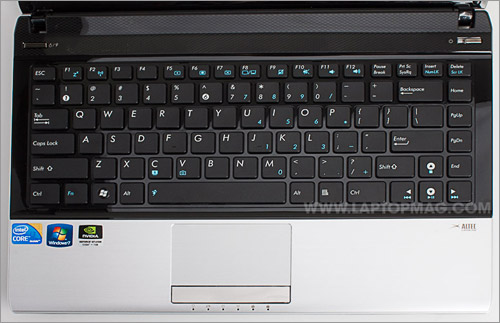
Click to enlarge
Ports and Webcam
The right side of the U31JG-A1 houses a Kensington lock slot, power jack, USB 2.0 port, and headphone and mic jacks. Two more USB ports line the right side of the notebook--no USB 3.0 here--along with HDMI, a memory card reader, Ethernet, and VGA. You don't get a built-in optical drive, a trade-off more and more people are willing to make for portability.

Click to enlarge

Click to enlarge
Equipped with a 0.3-MP webcam, the U31JG offered clear call quality over Skype. The other caller said she could easily make out our blue shirt and even details in the background. However, she also said that the sound echoed a bit, as if we were in a tunnel.
Heat
After playing a Hulu video for 15 minutes, we measured mostly cool temperatures coming from the U31JG-A1. The touchpad registered just 82 degrees and the space between the G&H keys reached 90 degrees. The underside got a bit toasty at 94 degrees, but that's still below the threshold of what we consider uncomfortable (95).
Display and Audio
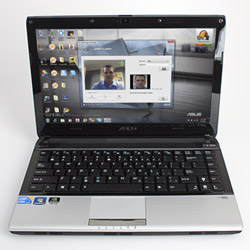
Click to enlargeThe U31JG's 13-inch display (1366 x 768 pixels) doesn't exactly wow. That's because of the narrow viewing angles, especially vertically. We had to tilt the screen back to avoid the picture getting washed out. Horizontal angles were more generous, and colors were vibrant when watching a Jeopardy Saturday Night Live skit on Hulu.
The front-facing Altec Lansing speakers produced loud and clear audio when listening to that SNL skit, and they also pumped out a fair amount of volume when streaming Green Day's "Brain Stew" on Slacker. Brandon Flowers' "Crossfire" sounded somewhat hollow but had plenty of punch for this size notebook.
Performance
A last-generation 2.53-GHz Core i3 processor, 4GB of RAM, and a 5,400-rpm hard drive run the show on the U31JG-A1. These components, paired with Nvidia's GeForce GT 415M graphics, paced this thin-and-light notebook to a PCMark Vantage score of 5,550. That showing is above the category average (4,986), and way above the HP Pavilion dm3t (3,669). However, the Acer Aspire TimelineX 4820TG and Toshiba Portege R835 both scored above 6,000 because they pack Core i5 processors. The 14-inch U41Jf, which has practically the same specs as this ASUS notebook, scored 5,510.
In everyday use, the U31JG proved to be snappy, but not when booting. It took the notebook 1 minute and 22 seconds to start Windows. When we used the Fast Boot utility to delay certain applications from launching upon startup, it didn't make a difference.
Once the U31JG warms up, though, it's a very capable notebook. The system transcoded a 114MB MPEG-4 video to AVI in 47 seconds, which is faster than the average thin-and-light laptop (1:01) and the same time achieved by the Acer 4820TG and Asus U41Jf. By comparison, the HP Pavilion dm3t took 1:51 to perform the same task.
The 5,400-rpm drive on the U31JG turned in a transfer rate of 26.8 Mbps, which is a bit above the 24.5 Mbps average.
Graphics Performance
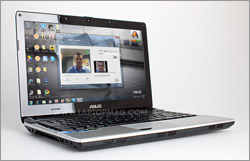
Click to enlargeThanks to Nvidia's Optimus technology, the U31JG automatically switches between its discrete GeForce GT 415M GPU and Intel's integrated graphics depending on the task. The dedicated graphics card notched a 3DMark06 score of 4,371, which is about 1,000 points above the average thin-and-light laptop but well below what the Acer 4820TG (7,844) turned in. That 14-inch notebook has more powerful AMD HD 6550M graphics, but it doesn't seamlessly switch back and forth between integrated and discrete modes.
Regardless, you can definitely get your game on with the U31JG. When we fired up World of Warcraft the machine delivered 61 frames per second at native resolution and the settings set to good. Far Cry 2 proved more of a challenge, with the notebook mustering a barely playable 26 fps at a lower resolution of 1024 x 768. That score is in between the U36Jc (22 fps, GeForce 310M) and U41Jf (37 fps, GeForce 425M).
Express Gate and Instant On
As with other ASUS machines, the U31JG has the ability to quickly boot into a Linux-based operating system. Called Express Gate, this OS allows fast access to a rudimentary browser, along with basic games and saved photos. The whole setup boots in about 20 seconds, but the interface is clunky and it takes too many steps to set up a wireless connection.
Battery Life and Wireless
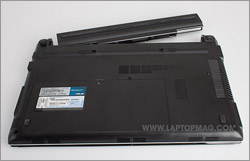
Click to enlargeYou can expect to get through most if not all of the day on a full charge with the U31JG. On the LAPTOP Battery Test (continuous surfing over Wi-Fi), the notebook lasted 6 hours and 29 minutes. This runtime is nearly an hour and a half longer than the typical thin and light notebook and 18 minutes longer than the typical ultraportable--since this machine straddles both of those categories. The Toshiba Portege R835 lasted just about as long (6:22), as did the U36JC-A1 (6:24).
ASUS opted for a Realtek RTL8191SE 802.11n wireless card in this laptop instead of Intel's Wi-Fi, and it didn't really hurt. The U31JG achieved a data rate of 37 Mbps at 15 feet from our router, which dipped to 19.2 Mbps at 50 feet. The typical thin-and-light notebook delivers 34 and 22 Mbps from those distances, respectively.
Software and Warranty
The U31JG comes with a sizeable amount of software pre-loaded. There's Google Chrome, plus Windows Live Essentials and trial versions of Microsoft Office 2010 and Trend Micro Internet Security.
The ASUS-branded FancyStart controls what splash screen will appear during the boot process and FastBoot attempts to speed up boot time by delaying when software loads (though it didn't work for us). The SmartLogon manager lets you log into the system using face recognition, and we found the setup process to be much quicker than on Toshiba's notebooks.
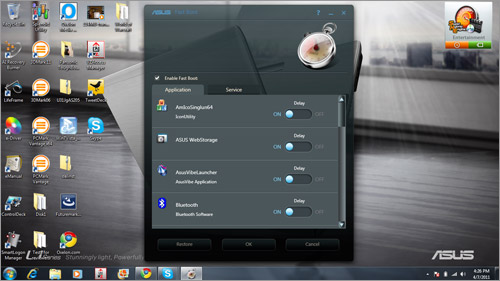
Click to enlarge
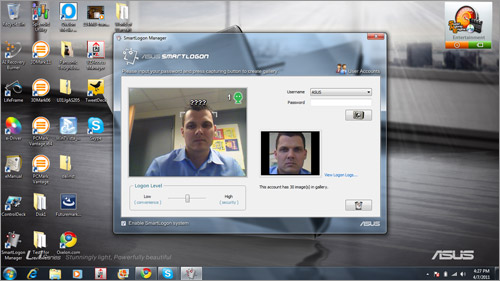
Click to enlarge
ASUS backs the U31JG with a relatively strong two-year warranty covering one year of accidental damage. This includes 24-7 toll-free phone tech support. See how ASUS fared in our Tech Support Showdown and in our Best & Worst Laptop Brands report.
Verdict
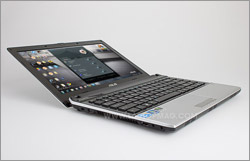
Click to enlargeThe ASUS U31JG-A1 doesn't break a lot of new ground. It's just a solid thin-and-light notebook that provides a welcome one-two punch of graphics performance and long battery life. We just wish ASUS could take the flex out of its keyboards. In this price range, we prefer the 14-inch Acer Aspire TimelineX 4820TG ($799) because it packs in more powerful graphics without adding much weight--though you do sacrifice about an hour of juice. The Portege R835 is thinner, lighter, and faster than both the ASUS and Acer, but you can't really game on it. While we actually prefer the design of the 13-inch ASUS U36Jc, it's about $155 more and has slightly weaker graphics. Some may want to wait for ASUS to add the latest second-generation Core processors to its U3 line, but overall the U31JG is a thin-and-light notebook that delivers.
ASUS U31JG-A1 Specs
| Bluetooth | none |
| Brand | ASUS |
| CPU | 2.53-GHz Intel Core i3-380M |
| Card Slots | 2-1 card reader |
| Company Website | http://www.asus.com |
| Display Size | 13.3 |
| Graphics Card | Nvidia GeForce GT 415M/ Intel GMA HD |
| Hard Drive Size | 500GB |
| Hard Drive Speed | 5,400rpm |
| Hard Drive Type | SATA Hard Drive |
| Mobile Broadband | none |
| Native Resolution | 1366x768 |
| Operating System | MS Windows 7 Home Premium (64-bit) |
| Optical Drive | None |
| Optical Drive Speed | n/a |
| Ports (excluding USB) | Kensington Lock, Headphone, HDMI, Ethernet, VGA, Microphone |
| RAM | 4GB |
| RAM Upgradable to | 8GB |
| Size | 13.1 x 9.5 x 0.8-1.2 inches |
| Touchpad Size | 3.1 x 1.8 inches |
| USB Ports | 3 |
| Video Memory | 1GB |
| Warranty/Support | Two years/ 24/7 toll free |
| Weight | 4.2 pounds |
| Wi-Fi | 802.11b/g/n |
| Wi-Fi Model | Realtek RTL8191SE |

